Operations Management Report: Theories, Analysis, and Solutions
VerifiedAdded on 2019/12/18
|9
|2618
|75
Report
AI Summary
This report provides a comprehensive overview of operations management, beginning with an introduction to the field's significance within an organization. It then delves into a critical review of various relevant operations management theories, including contingency theory, systems theory, scientific management, administrative theory, bureaucratic theory, human relations theory, X&Y theory, and chaos theory. The report analyzes each theory's principles and applications. Following the theoretical review, the report presents an analytic discussion of operations management, focusing on human resource management and its impact on organizational operations. It explores specific operational areas such as job roles, recruitment and selection, training and development, and compensation and benefits, offering practical solutions and examples. The conclusion emphasizes the importance of effective operations management across various functions, from product and service design to supply chain management, highlighting its influence on overall organizational performance.
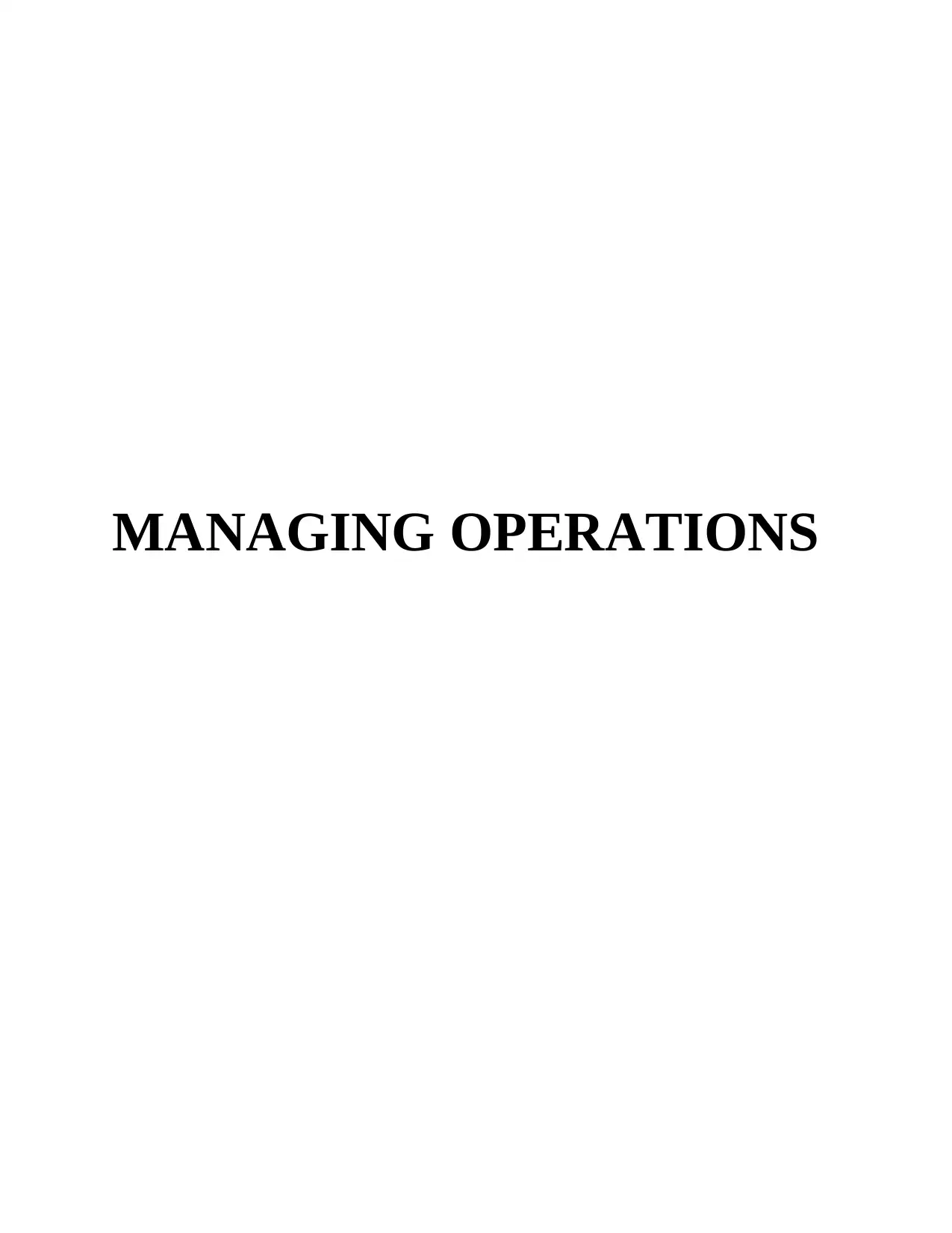
MANAGING OPERATIONS
Paraphrase This Document
Need a fresh take? Get an instant paraphrase of this document with our AI Paraphraser
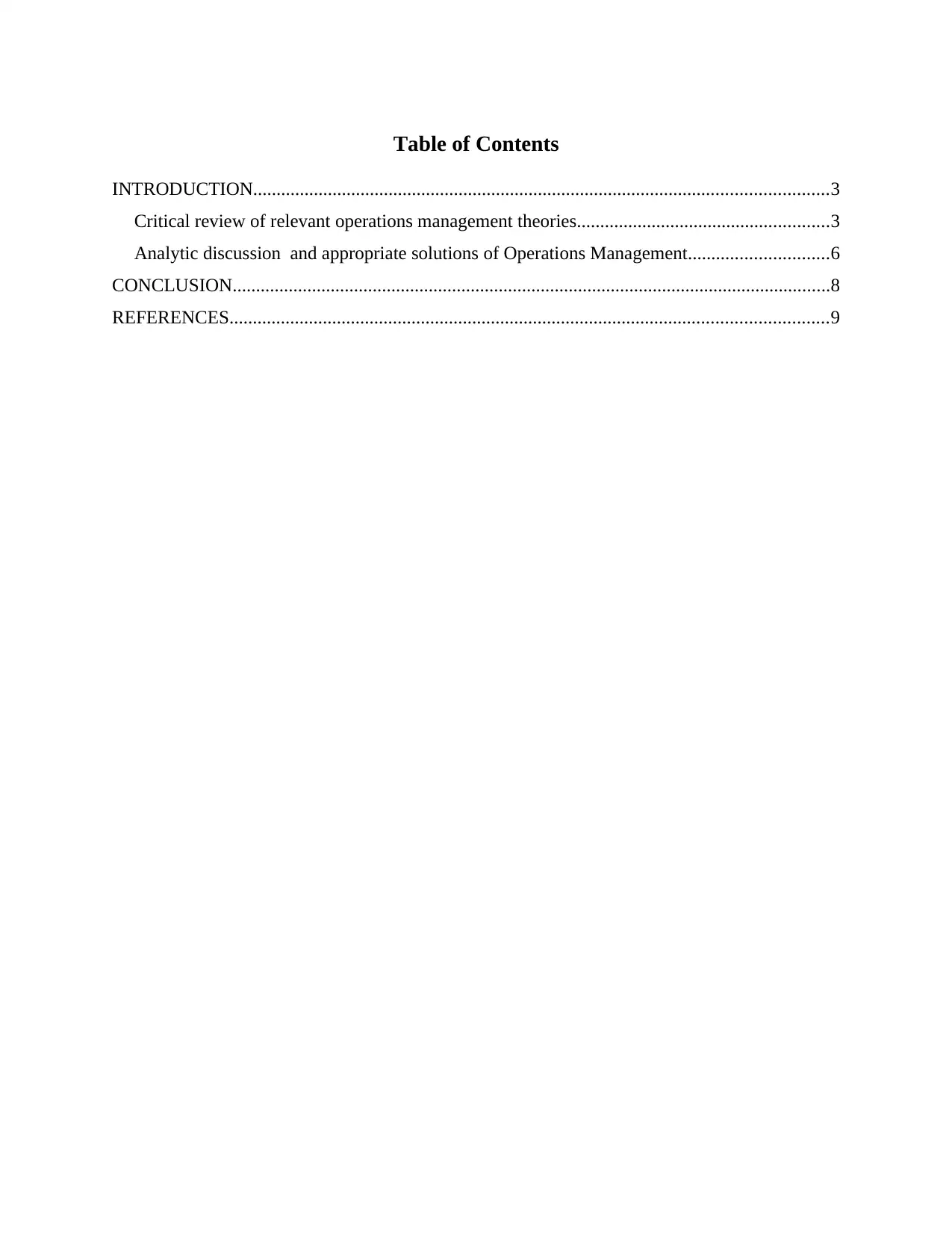
Table of Contents
INTRODUCTION...........................................................................................................................3
Critical review of relevant operations management theories......................................................3
Analytic discussion and appropriate solutions of Operations Management..............................6
CONCLUSION................................................................................................................................8
REFERENCES................................................................................................................................9
INTRODUCTION...........................................................................................................................3
Critical review of relevant operations management theories......................................................3
Analytic discussion and appropriate solutions of Operations Management..............................6
CONCLUSION................................................................................................................................8
REFERENCES................................................................................................................................9
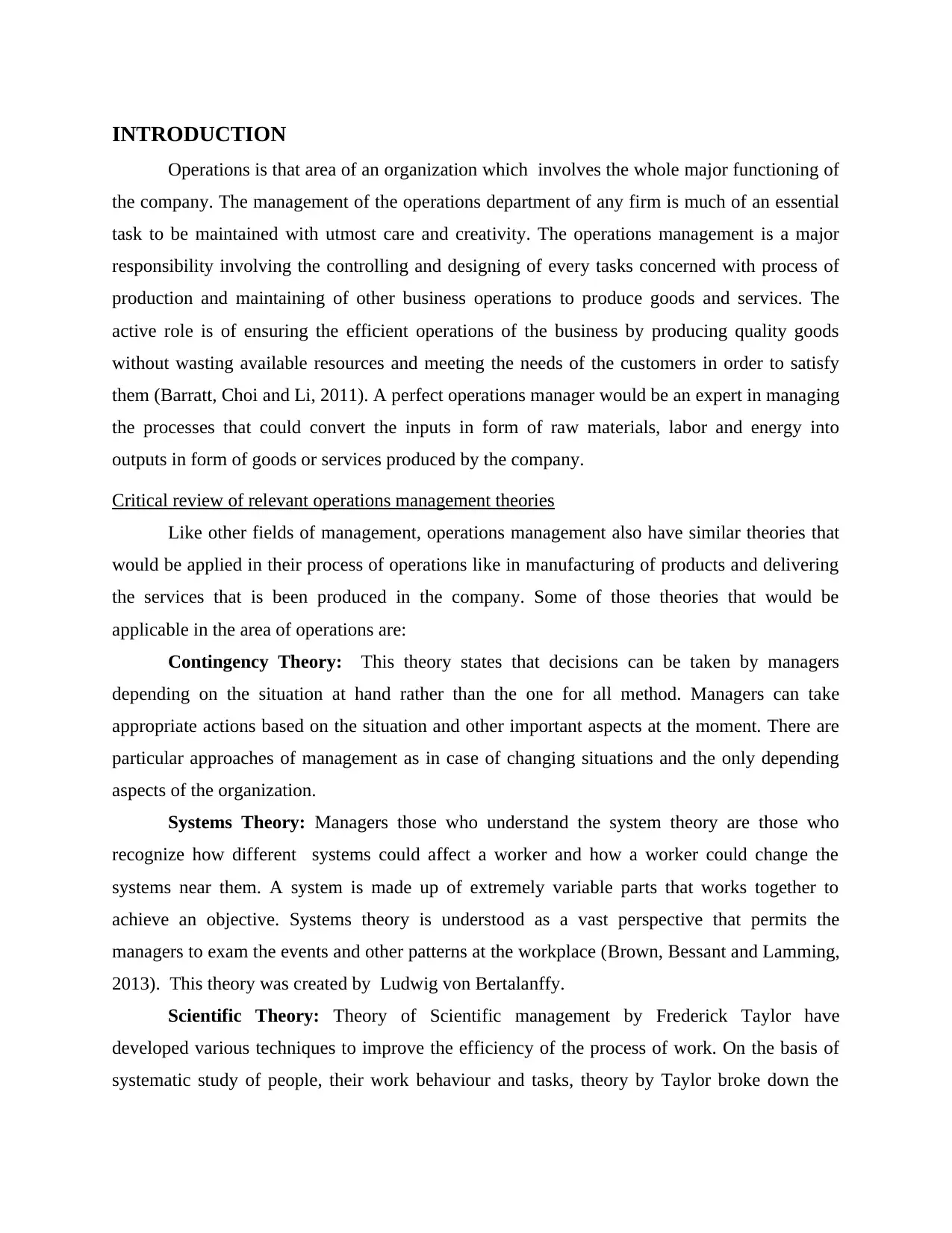
INTRODUCTION
Operations is that area of an organization which involves the whole major functioning of
the company. The management of the operations department of any firm is much of an essential
task to be maintained with utmost care and creativity. The operations management is a major
responsibility involving the controlling and designing of every tasks concerned with process of
production and maintaining of other business operations to produce goods and services. The
active role is of ensuring the efficient operations of the business by producing quality goods
without wasting available resources and meeting the needs of the customers in order to satisfy
them (Barratt, Choi and Li, 2011). A perfect operations manager would be an expert in managing
the processes that could convert the inputs in form of raw materials, labor and energy into
outputs in form of goods or services produced by the company.
Critical review of relevant operations management theories
Like other fields of management, operations management also have similar theories that
would be applied in their process of operations like in manufacturing of products and delivering
the services that is been produced in the company. Some of those theories that would be
applicable in the area of operations are:
Contingency Theory: This theory states that decisions can be taken by managers
depending on the situation at hand rather than the one for all method. Managers can take
appropriate actions based on the situation and other important aspects at the moment. There are
particular approaches of management as in case of changing situations and the only depending
aspects of the organization.
Systems Theory: Managers those who understand the system theory are those who
recognize how different systems could affect a worker and how a worker could change the
systems near them. A system is made up of extremely variable parts that works together to
achieve an objective. Systems theory is understood as a vast perspective that permits the
managers to exam the events and other patterns at the workplace (Brown, Bessant and Lamming,
2013). This theory was created by Ludwig von Bertalanffy.
Scientific Theory: Theory of Scientific management by Frederick Taylor have
developed various techniques to improve the efficiency of the process of work. On the basis of
systematic study of people, their work behaviour and tasks, theory by Taylor broke down the
Operations is that area of an organization which involves the whole major functioning of
the company. The management of the operations department of any firm is much of an essential
task to be maintained with utmost care and creativity. The operations management is a major
responsibility involving the controlling and designing of every tasks concerned with process of
production and maintaining of other business operations to produce goods and services. The
active role is of ensuring the efficient operations of the business by producing quality goods
without wasting available resources and meeting the needs of the customers in order to satisfy
them (Barratt, Choi and Li, 2011). A perfect operations manager would be an expert in managing
the processes that could convert the inputs in form of raw materials, labor and energy into
outputs in form of goods or services produced by the company.
Critical review of relevant operations management theories
Like other fields of management, operations management also have similar theories that
would be applied in their process of operations like in manufacturing of products and delivering
the services that is been produced in the company. Some of those theories that would be
applicable in the area of operations are:
Contingency Theory: This theory states that decisions can be taken by managers
depending on the situation at hand rather than the one for all method. Managers can take
appropriate actions based on the situation and other important aspects at the moment. There are
particular approaches of management as in case of changing situations and the only depending
aspects of the organization.
Systems Theory: Managers those who understand the system theory are those who
recognize how different systems could affect a worker and how a worker could change the
systems near them. A system is made up of extremely variable parts that works together to
achieve an objective. Systems theory is understood as a vast perspective that permits the
managers to exam the events and other patterns at the workplace (Brown, Bessant and Lamming,
2013). This theory was created by Ludwig von Bertalanffy.
Scientific Theory: Theory of Scientific management by Frederick Taylor have
developed various techniques to improve the efficiency of the process of work. On the basis of
systematic study of people, their work behaviour and tasks, theory by Taylor broke down the
⊘ This is a preview!⊘
Do you want full access?
Subscribe today to unlock all pages.

Trusted by 1+ million students worldwide
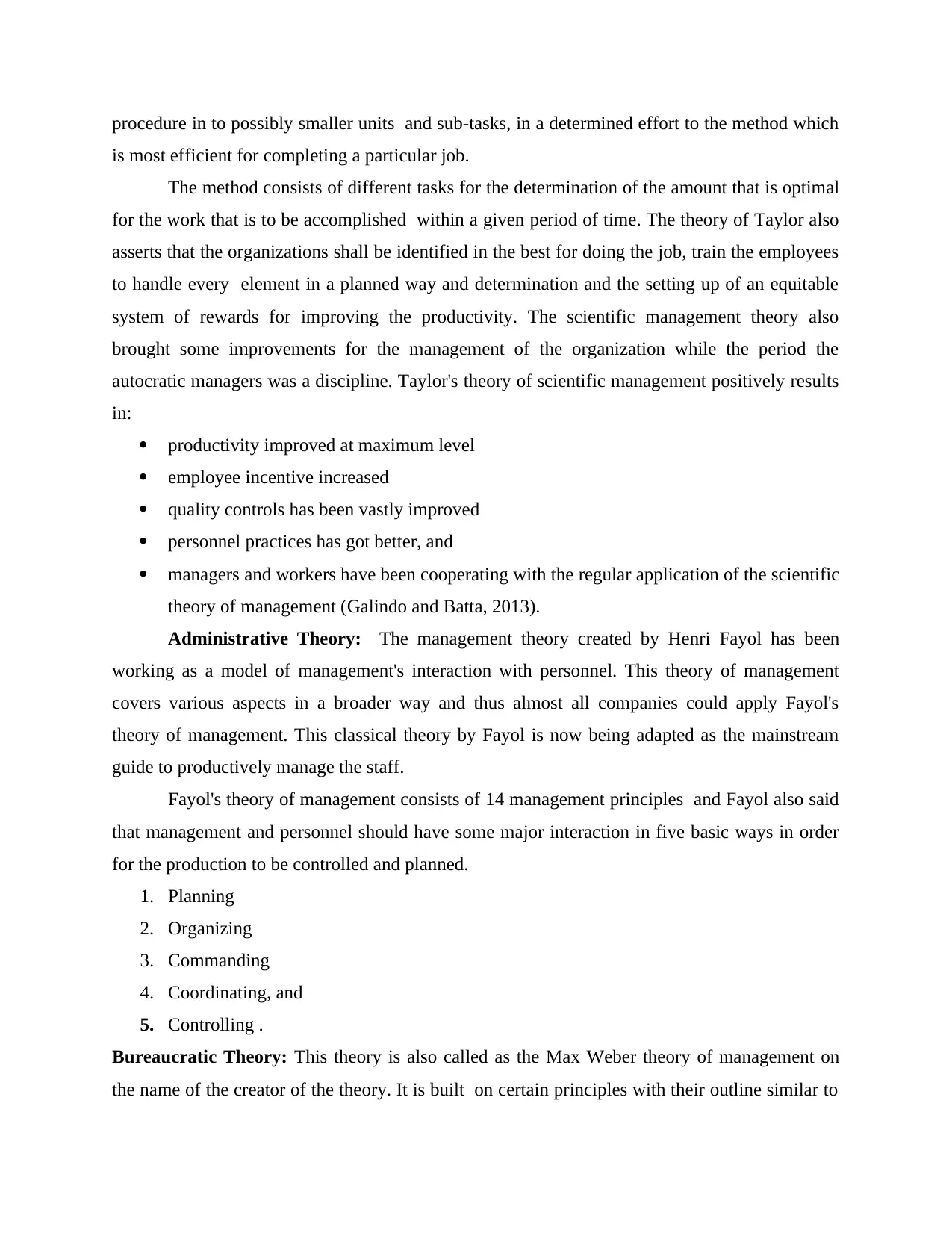
procedure in to possibly smaller units and sub-tasks, in a determined effort to the method which
is most efficient for completing a particular job.
The method consists of different tasks for the determination of the amount that is optimal
for the work that is to be accomplished within a given period of time. The theory of Taylor also
asserts that the organizations shall be identified in the best for doing the job, train the employees
to handle every element in a planned way and determination and the setting up of an equitable
system of rewards for improving the productivity. The scientific management theory also
brought some improvements for the management of the organization while the period the
autocratic managers was a discipline. Taylor's theory of scientific management positively results
in:
productivity improved at maximum level
employee incentive increased
quality controls has been vastly improved
personnel practices has got better, and
managers and workers have been cooperating with the regular application of the scientific
theory of management (Galindo and Batta, 2013).
Administrative Theory: The management theory created by Henri Fayol has been
working as a model of management's interaction with personnel. This theory of management
covers various aspects in a broader way and thus almost all companies could apply Fayol's
theory of management. This classical theory by Fayol is now being adapted as the mainstream
guide to productively manage the staff.
Fayol's theory of management consists of 14 management principles and Fayol also said
that management and personnel should have some major interaction in five basic ways in order
for the production to be controlled and planned.
1. Planning
2. Organizing
3. Commanding
4. Coordinating, and
5. Controlling .
Bureaucratic Theory: This theory is also called as the Max Weber theory of management on
the name of the creator of the theory. It is built on certain principles with their outline similar to
is most efficient for completing a particular job.
The method consists of different tasks for the determination of the amount that is optimal
for the work that is to be accomplished within a given period of time. The theory of Taylor also
asserts that the organizations shall be identified in the best for doing the job, train the employees
to handle every element in a planned way and determination and the setting up of an equitable
system of rewards for improving the productivity. The scientific management theory also
brought some improvements for the management of the organization while the period the
autocratic managers was a discipline. Taylor's theory of scientific management positively results
in:
productivity improved at maximum level
employee incentive increased
quality controls has been vastly improved
personnel practices has got better, and
managers and workers have been cooperating with the regular application of the scientific
theory of management (Galindo and Batta, 2013).
Administrative Theory: The management theory created by Henri Fayol has been
working as a model of management's interaction with personnel. This theory of management
covers various aspects in a broader way and thus almost all companies could apply Fayol's
theory of management. This classical theory by Fayol is now being adapted as the mainstream
guide to productively manage the staff.
Fayol's theory of management consists of 14 management principles and Fayol also said
that management and personnel should have some major interaction in five basic ways in order
for the production to be controlled and planned.
1. Planning
2. Organizing
3. Commanding
4. Coordinating, and
5. Controlling .
Bureaucratic Theory: This theory is also called as the Max Weber theory of management on
the name of the creator of the theory. It is built on certain principles with their outline similar to
Paraphrase This Document
Need a fresh take? Get an instant paraphrase of this document with our AI Paraphraser
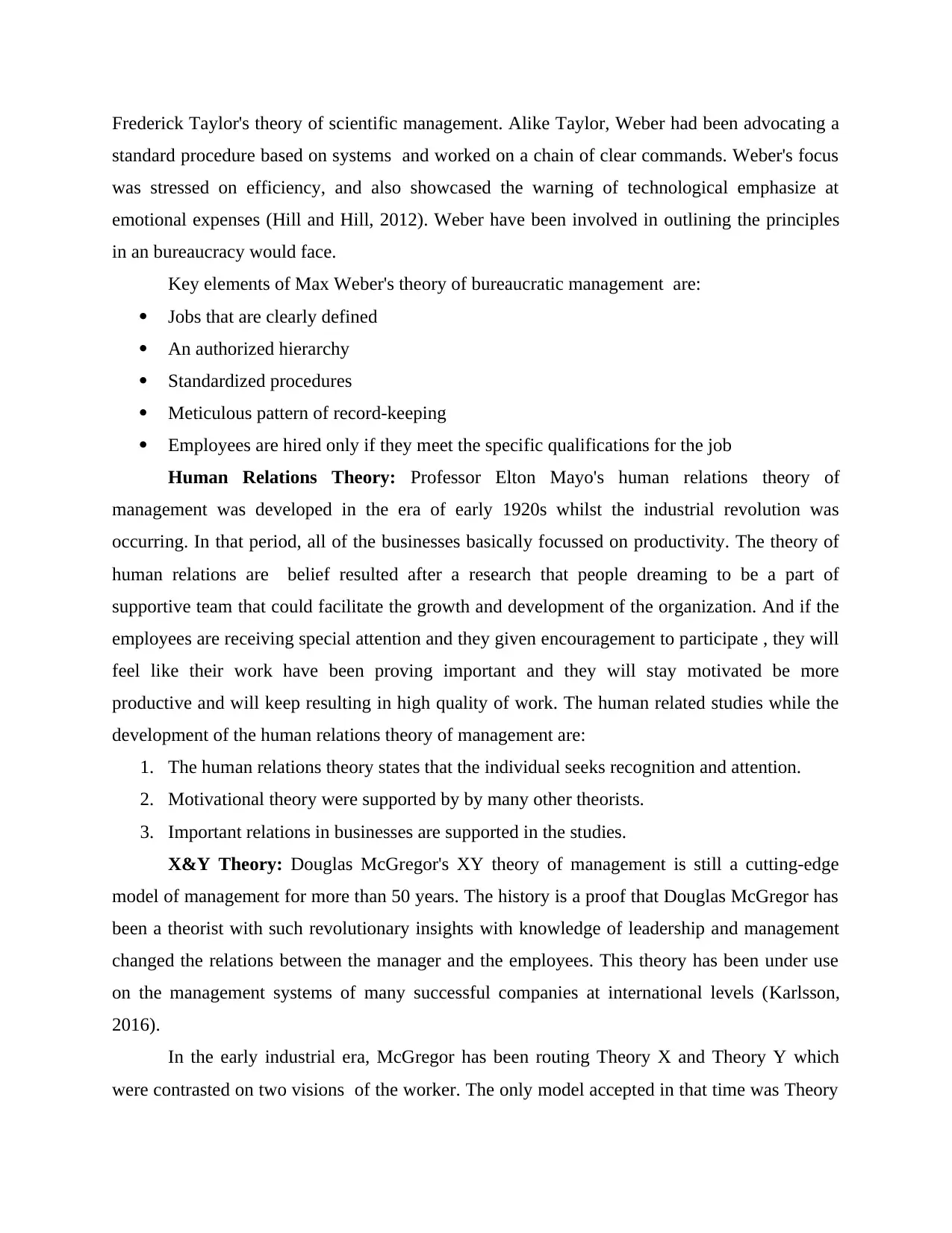
Frederick Taylor's theory of scientific management. Alike Taylor, Weber had been advocating a
standard procedure based on systems and worked on a chain of clear commands. Weber's focus
was stressed on efficiency, and also showcased the warning of technological emphasize at
emotional expenses (Hill and Hill, 2012). Weber have been involved in outlining the principles
in an bureaucracy would face.
Key elements of Max Weber's theory of bureaucratic management are:
Jobs that are clearly defined
An authorized hierarchy
Standardized procedures
Meticulous pattern of record-keeping
Employees are hired only if they meet the specific qualifications for the job
Human Relations Theory: Professor Elton Mayo's human relations theory of
management was developed in the era of early 1920s whilst the industrial revolution was
occurring. In that period, all of the businesses basically focussed on productivity. The theory of
human relations are belief resulted after a research that people dreaming to be a part of
supportive team that could facilitate the growth and development of the organization. And if the
employees are receiving special attention and they given encouragement to participate , they will
feel like their work have been proving important and they will stay motivated be more
productive and will keep resulting in high quality of work. The human related studies while the
development of the human relations theory of management are:
1. The human relations theory states that the individual seeks recognition and attention.
2. Motivational theory were supported by by many other theorists.
3. Important relations in businesses are supported in the studies.
X&Y Theory: Douglas McGregor's XY theory of management is still a cutting-edge
model of management for more than 50 years. The history is a proof that Douglas McGregor has
been a theorist with such revolutionary insights with knowledge of leadership and management
changed the relations between the manager and the employees. This theory has been under use
on the management systems of many successful companies at international levels (Karlsson,
2016).
In the early industrial era, McGregor has been routing Theory X and Theory Y which
were contrasted on two visions of the worker. The only model accepted in that time was Theory
standard procedure based on systems and worked on a chain of clear commands. Weber's focus
was stressed on efficiency, and also showcased the warning of technological emphasize at
emotional expenses (Hill and Hill, 2012). Weber have been involved in outlining the principles
in an bureaucracy would face.
Key elements of Max Weber's theory of bureaucratic management are:
Jobs that are clearly defined
An authorized hierarchy
Standardized procedures
Meticulous pattern of record-keeping
Employees are hired only if they meet the specific qualifications for the job
Human Relations Theory: Professor Elton Mayo's human relations theory of
management was developed in the era of early 1920s whilst the industrial revolution was
occurring. In that period, all of the businesses basically focussed on productivity. The theory of
human relations are belief resulted after a research that people dreaming to be a part of
supportive team that could facilitate the growth and development of the organization. And if the
employees are receiving special attention and they given encouragement to participate , they will
feel like their work have been proving important and they will stay motivated be more
productive and will keep resulting in high quality of work. The human related studies while the
development of the human relations theory of management are:
1. The human relations theory states that the individual seeks recognition and attention.
2. Motivational theory were supported by by many other theorists.
3. Important relations in businesses are supported in the studies.
X&Y Theory: Douglas McGregor's XY theory of management is still a cutting-edge
model of management for more than 50 years. The history is a proof that Douglas McGregor has
been a theorist with such revolutionary insights with knowledge of leadership and management
changed the relations between the manager and the employees. This theory has been under use
on the management systems of many successful companies at international levels (Karlsson,
2016).
In the early industrial era, McGregor has been routing Theory X and Theory Y which
were contrasted on two visions of the worker. The only model accepted in that time was Theory
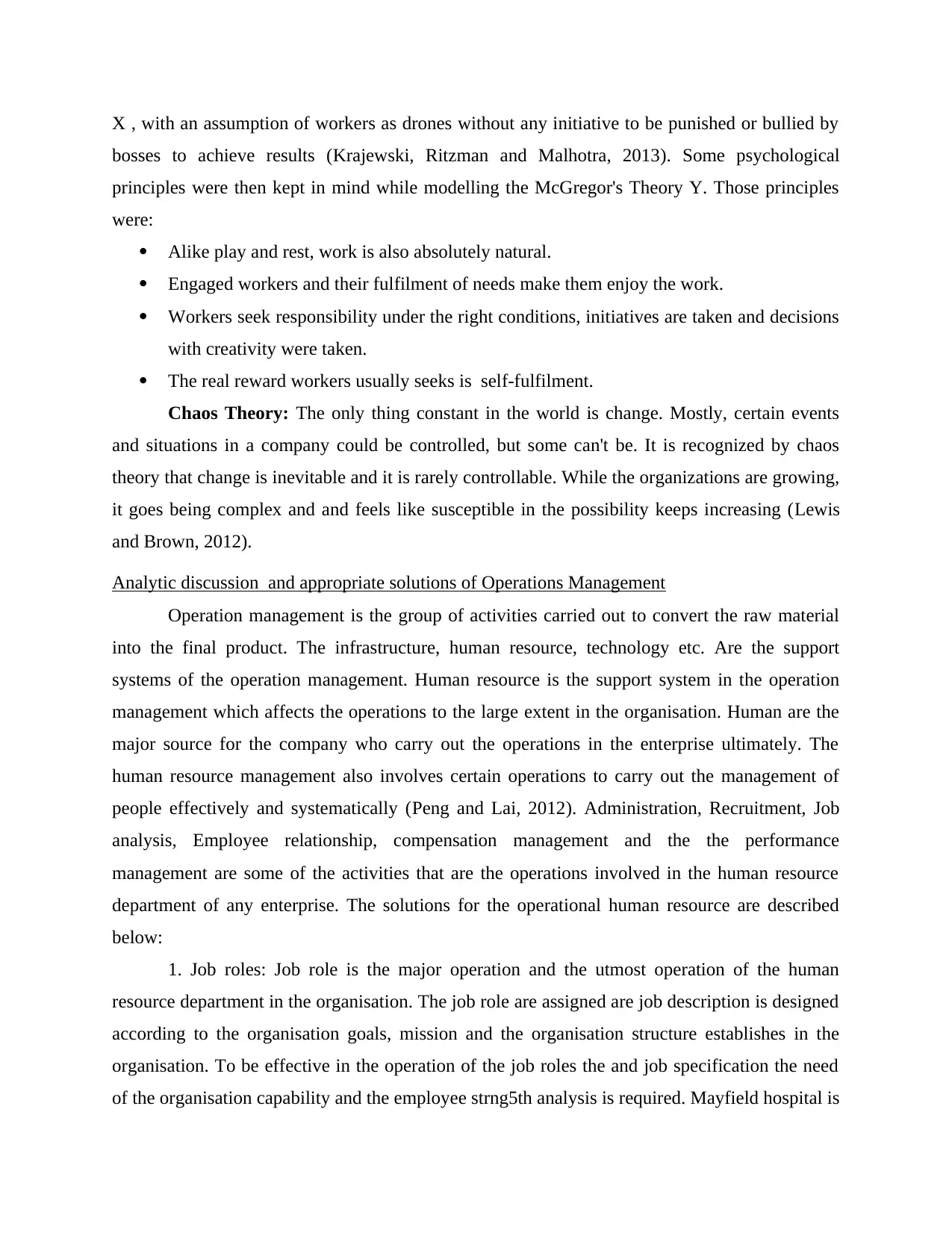
X , with an assumption of workers as drones without any initiative to be punished or bullied by
bosses to achieve results (Krajewski, Ritzman and Malhotra, 2013). Some psychological
principles were then kept in mind while modelling the McGregor's Theory Y. Those principles
were:
Alike play and rest, work is also absolutely natural.
Engaged workers and their fulfilment of needs make them enjoy the work.
Workers seek responsibility under the right conditions, initiatives are taken and decisions
with creativity were taken.
The real reward workers usually seeks is self-fulfilment.
Chaos Theory: The only thing constant in the world is change. Mostly, certain events
and situations in a company could be controlled, but some can't be. It is recognized by chaos
theory that change is inevitable and it is rarely controllable. While the organizations are growing,
it goes being complex and and feels like susceptible in the possibility keeps increasing (Lewis
and Brown, 2012).
Analytic discussion and appropriate solutions of Operations Management
Operation management is the group of activities carried out to convert the raw material
into the final product. The infrastructure, human resource, technology etc. Are the support
systems of the operation management. Human resource is the support system in the operation
management which affects the operations to the large extent in the organisation. Human are the
major source for the company who carry out the operations in the enterprise ultimately. The
human resource management also involves certain operations to carry out the management of
people effectively and systematically (Peng and Lai, 2012). Administration, Recruitment, Job
analysis, Employee relationship, compensation management and the the performance
management are some of the activities that are the operations involved in the human resource
department of any enterprise. The solutions for the operational human resource are described
below:
1. Job roles: Job role is the major operation and the utmost operation of the human
resource department in the organisation. The job role are assigned are job description is designed
according to the organisation goals, mission and the organisation structure establishes in the
organisation. To be effective in the operation of the job roles the and job specification the need
of the organisation capability and the employee strng5th analysis is required. Mayfield hospital is
bosses to achieve results (Krajewski, Ritzman and Malhotra, 2013). Some psychological
principles were then kept in mind while modelling the McGregor's Theory Y. Those principles
were:
Alike play and rest, work is also absolutely natural.
Engaged workers and their fulfilment of needs make them enjoy the work.
Workers seek responsibility under the right conditions, initiatives are taken and decisions
with creativity were taken.
The real reward workers usually seeks is self-fulfilment.
Chaos Theory: The only thing constant in the world is change. Mostly, certain events
and situations in a company could be controlled, but some can't be. It is recognized by chaos
theory that change is inevitable and it is rarely controllable. While the organizations are growing,
it goes being complex and and feels like susceptible in the possibility keeps increasing (Lewis
and Brown, 2012).
Analytic discussion and appropriate solutions of Operations Management
Operation management is the group of activities carried out to convert the raw material
into the final product. The infrastructure, human resource, technology etc. Are the support
systems of the operation management. Human resource is the support system in the operation
management which affects the operations to the large extent in the organisation. Human are the
major source for the company who carry out the operations in the enterprise ultimately. The
human resource management also involves certain operations to carry out the management of
people effectively and systematically (Peng and Lai, 2012). Administration, Recruitment, Job
analysis, Employee relationship, compensation management and the the performance
management are some of the activities that are the operations involved in the human resource
department of any enterprise. The solutions for the operational human resource are described
below:
1. Job roles: Job role is the major operation and the utmost operation of the human
resource department in the organisation. The job role are assigned are job description is designed
according to the organisation goals, mission and the organisation structure establishes in the
organisation. To be effective in the operation of the job roles the and job specification the need
of the organisation capability and the employee strng5th analysis is required. Mayfield hospital is
⊘ This is a preview!⊘
Do you want full access?
Subscribe today to unlock all pages.

Trusted by 1+ million students worldwide
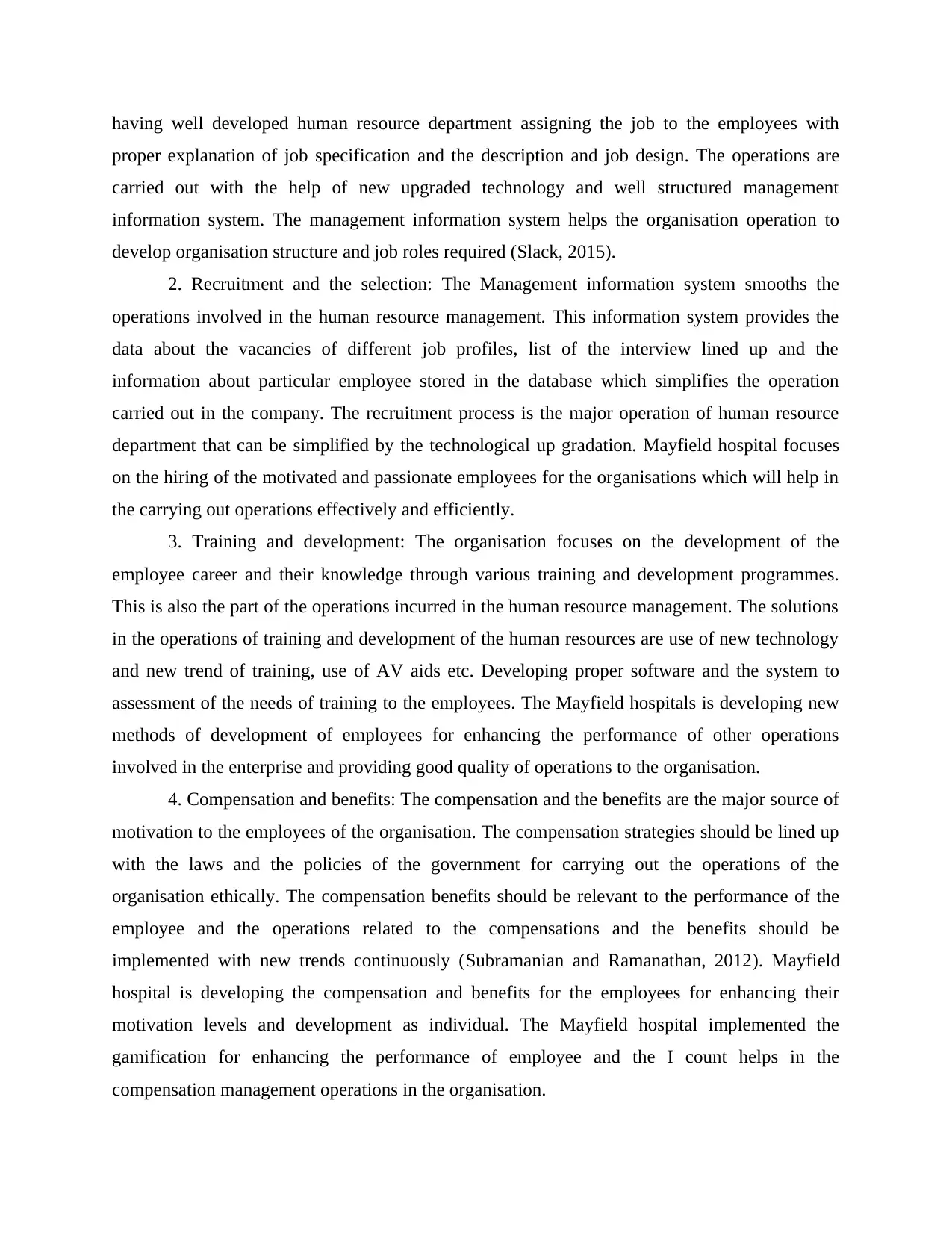
having well developed human resource department assigning the job to the employees with
proper explanation of job specification and the description and job design. The operations are
carried out with the help of new upgraded technology and well structured management
information system. The management information system helps the organisation operation to
develop organisation structure and job roles required (Slack, 2015).
2. Recruitment and the selection: The Management information system smooths the
operations involved in the human resource management. This information system provides the
data about the vacancies of different job profiles, list of the interview lined up and the
information about particular employee stored in the database which simplifies the operation
carried out in the company. The recruitment process is the major operation of human resource
department that can be simplified by the technological up gradation. Mayfield hospital focuses
on the hiring of the motivated and passionate employees for the organisations which will help in
the carrying out operations effectively and efficiently.
3. Training and development: The organisation focuses on the development of the
employee career and their knowledge through various training and development programmes.
This is also the part of the operations incurred in the human resource management. The solutions
in the operations of training and development of the human resources are use of new technology
and new trend of training, use of AV aids etc. Developing proper software and the system to
assessment of the needs of training to the employees. The Mayfield hospitals is developing new
methods of development of employees for enhancing the performance of other operations
involved in the enterprise and providing good quality of operations to the organisation.
4. Compensation and benefits: The compensation and the benefits are the major source of
motivation to the employees of the organisation. The compensation strategies should be lined up
with the laws and the policies of the government for carrying out the operations of the
organisation ethically. The compensation benefits should be relevant to the performance of the
employee and the operations related to the compensations and the benefits should be
implemented with new trends continuously (Subramanian and Ramanathan, 2012). Mayfield
hospital is developing the compensation and benefits for the employees for enhancing their
motivation levels and development as individual. The Mayfield hospital implemented the
gamification for enhancing the performance of employee and the I count helps in the
compensation management operations in the organisation.
proper explanation of job specification and the description and job design. The operations are
carried out with the help of new upgraded technology and well structured management
information system. The management information system helps the organisation operation to
develop organisation structure and job roles required (Slack, 2015).
2. Recruitment and the selection: The Management information system smooths the
operations involved in the human resource management. This information system provides the
data about the vacancies of different job profiles, list of the interview lined up and the
information about particular employee stored in the database which simplifies the operation
carried out in the company. The recruitment process is the major operation of human resource
department that can be simplified by the technological up gradation. Mayfield hospital focuses
on the hiring of the motivated and passionate employees for the organisations which will help in
the carrying out operations effectively and efficiently.
3. Training and development: The organisation focuses on the development of the
employee career and their knowledge through various training and development programmes.
This is also the part of the operations incurred in the human resource management. The solutions
in the operations of training and development of the human resources are use of new technology
and new trend of training, use of AV aids etc. Developing proper software and the system to
assessment of the needs of training to the employees. The Mayfield hospitals is developing new
methods of development of employees for enhancing the performance of other operations
involved in the enterprise and providing good quality of operations to the organisation.
4. Compensation and benefits: The compensation and the benefits are the major source of
motivation to the employees of the organisation. The compensation strategies should be lined up
with the laws and the policies of the government for carrying out the operations of the
organisation ethically. The compensation benefits should be relevant to the performance of the
employee and the operations related to the compensations and the benefits should be
implemented with new trends continuously (Subramanian and Ramanathan, 2012). Mayfield
hospital is developing the compensation and benefits for the employees for enhancing their
motivation levels and development as individual. The Mayfield hospital implemented the
gamification for enhancing the performance of employee and the I count helps in the
compensation management operations in the organisation.
Paraphrase This Document
Need a fresh take? Get an instant paraphrase of this document with our AI Paraphraser
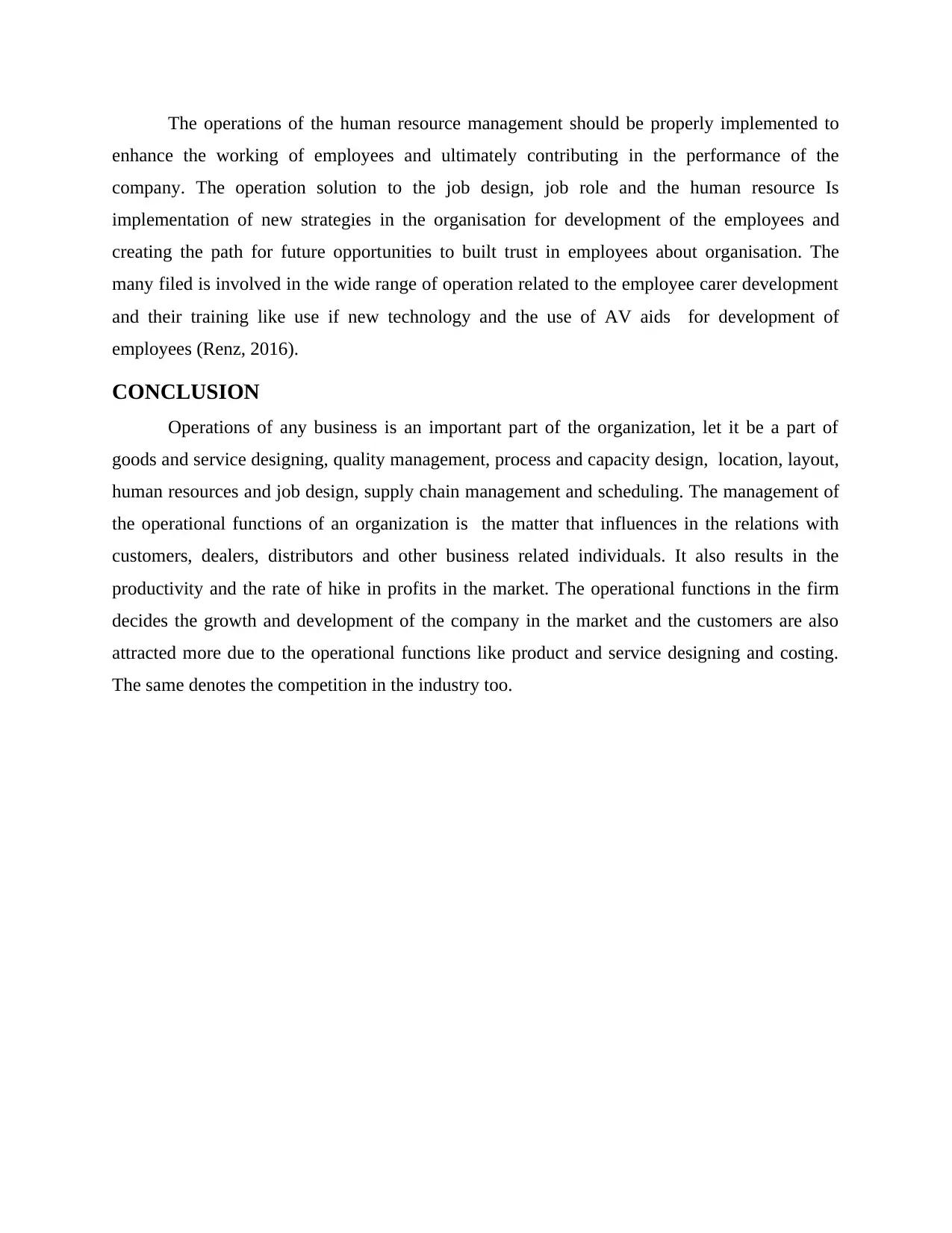
The operations of the human resource management should be properly implemented to
enhance the working of employees and ultimately contributing in the performance of the
company. The operation solution to the job design, job role and the human resource Is
implementation of new strategies in the organisation for development of the employees and
creating the path for future opportunities to built trust in employees about organisation. The
many filed is involved in the wide range of operation related to the employee carer development
and their training like use if new technology and the use of AV aids for development of
employees (Renz, 2016).
CONCLUSION
Operations of any business is an important part of the organization, let it be a part of
goods and service designing, quality management, process and capacity design, location, layout,
human resources and job design, supply chain management and scheduling. The management of
the operational functions of an organization is the matter that influences in the relations with
customers, dealers, distributors and other business related individuals. It also results in the
productivity and the rate of hike in profits in the market. The operational functions in the firm
decides the growth and development of the company in the market and the customers are also
attracted more due to the operational functions like product and service designing and costing.
The same denotes the competition in the industry too.
enhance the working of employees and ultimately contributing in the performance of the
company. The operation solution to the job design, job role and the human resource Is
implementation of new strategies in the organisation for development of the employees and
creating the path for future opportunities to built trust in employees about organisation. The
many filed is involved in the wide range of operation related to the employee carer development
and their training like use if new technology and the use of AV aids for development of
employees (Renz, 2016).
CONCLUSION
Operations of any business is an important part of the organization, let it be a part of
goods and service designing, quality management, process and capacity design, location, layout,
human resources and job design, supply chain management and scheduling. The management of
the operational functions of an organization is the matter that influences in the relations with
customers, dealers, distributors and other business related individuals. It also results in the
productivity and the rate of hike in profits in the market. The operational functions in the firm
decides the growth and development of the company in the market and the customers are also
attracted more due to the operational functions like product and service designing and costing.
The same denotes the competition in the industry too.
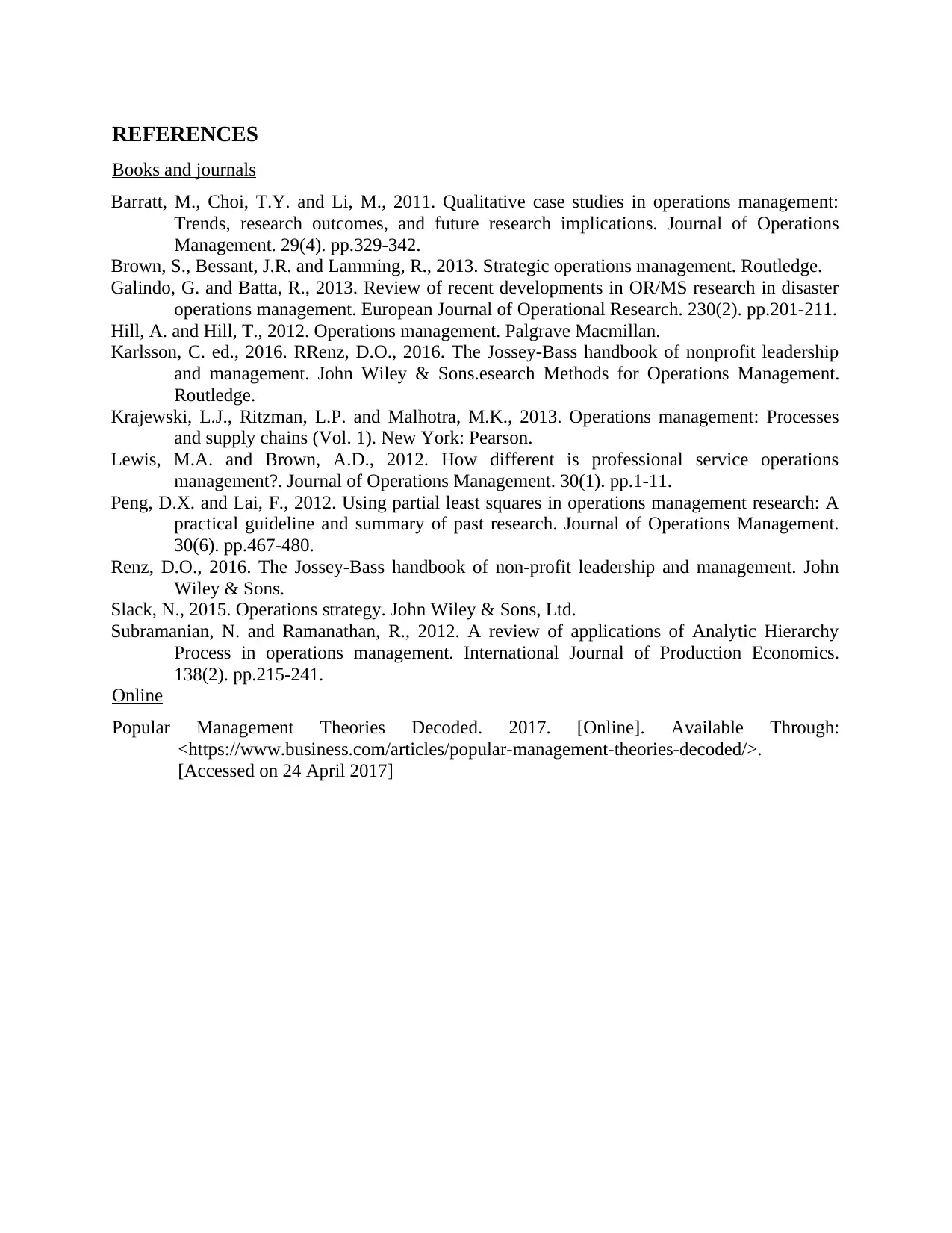
REFERENCES
Books and journals
Barratt, M., Choi, T.Y. and Li, M., 2011. Qualitative case studies in operations management:
Trends, research outcomes, and future research implications. Journal of Operations
Management. 29(4). pp.329-342.
Brown, S., Bessant, J.R. and Lamming, R., 2013. Strategic operations management. Routledge.
Galindo, G. and Batta, R., 2013. Review of recent developments in OR/MS research in disaster
operations management. European Journal of Operational Research. 230(2). pp.201-211.
Hill, A. and Hill, T., 2012. Operations management. Palgrave Macmillan.
Karlsson, C. ed., 2016. RRenz, D.O., 2016. The Jossey-Bass handbook of nonprofit leadership
and management. John Wiley & Sons.esearch Methods for Operations Management.
Routledge.
Krajewski, L.J., Ritzman, L.P. and Malhotra, M.K., 2013. Operations management: Processes
and supply chains (Vol. 1). New York: Pearson.
Lewis, M.A. and Brown, A.D., 2012. How different is professional service operations
management?. Journal of Operations Management. 30(1). pp.1-11.
Peng, D.X. and Lai, F., 2012. Using partial least squares in operations management research: A
practical guideline and summary of past research. Journal of Operations Management.
30(6). pp.467-480.
Renz, D.O., 2016. The Jossey-Bass handbook of non-profit leadership and management. John
Wiley & Sons.
Slack, N., 2015. Operations strategy. John Wiley & Sons, Ltd.
Subramanian, N. and Ramanathan, R., 2012. A review of applications of Analytic Hierarchy
Process in operations management. International Journal of Production Economics.
138(2). pp.215-241.
Online
Popular Management Theories Decoded. 2017. [Online]. Available Through:
<https://www.business.com/articles/popular-management-theories-decoded/>.
[Accessed on 24 April 2017]
Books and journals
Barratt, M., Choi, T.Y. and Li, M., 2011. Qualitative case studies in operations management:
Trends, research outcomes, and future research implications. Journal of Operations
Management. 29(4). pp.329-342.
Brown, S., Bessant, J.R. and Lamming, R., 2013. Strategic operations management. Routledge.
Galindo, G. and Batta, R., 2013. Review of recent developments in OR/MS research in disaster
operations management. European Journal of Operational Research. 230(2). pp.201-211.
Hill, A. and Hill, T., 2012. Operations management. Palgrave Macmillan.
Karlsson, C. ed., 2016. RRenz, D.O., 2016. The Jossey-Bass handbook of nonprofit leadership
and management. John Wiley & Sons.esearch Methods for Operations Management.
Routledge.
Krajewski, L.J., Ritzman, L.P. and Malhotra, M.K., 2013. Operations management: Processes
and supply chains (Vol. 1). New York: Pearson.
Lewis, M.A. and Brown, A.D., 2012. How different is professional service operations
management?. Journal of Operations Management. 30(1). pp.1-11.
Peng, D.X. and Lai, F., 2012. Using partial least squares in operations management research: A
practical guideline and summary of past research. Journal of Operations Management.
30(6). pp.467-480.
Renz, D.O., 2016. The Jossey-Bass handbook of non-profit leadership and management. John
Wiley & Sons.
Slack, N., 2015. Operations strategy. John Wiley & Sons, Ltd.
Subramanian, N. and Ramanathan, R., 2012. A review of applications of Analytic Hierarchy
Process in operations management. International Journal of Production Economics.
138(2). pp.215-241.
Online
Popular Management Theories Decoded. 2017. [Online]. Available Through:
<https://www.business.com/articles/popular-management-theories-decoded/>.
[Accessed on 24 April 2017]
⊘ This is a preview!⊘
Do you want full access?
Subscribe today to unlock all pages.

Trusted by 1+ million students worldwide
1 out of 9
Related Documents
Your All-in-One AI-Powered Toolkit for Academic Success.
+13062052269
info@desklib.com
Available 24*7 on WhatsApp / Email
![[object Object]](/_next/static/media/star-bottom.7253800d.svg)
Unlock your academic potential
Copyright © 2020–2025 A2Z Services. All Rights Reserved. Developed and managed by ZUCOL.




